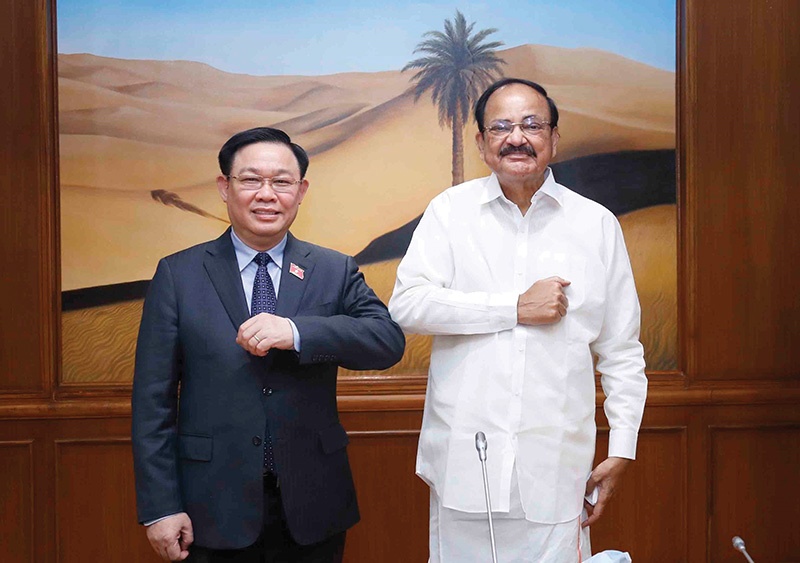Vietnam placed as key pillar for India’s Look East policy
 |
| By Vaibhav Saxena - Foreign counsel, VILAF |
Vietnam and India have shared strong bilateral relations historically. Relations between both countries have been marked by growing economic, commercial, and strategic considerations in the past few years. India is one of the fastest-growing economies in the world and currently ranks fifth globally in terms of GDP and is among the top ten trading partners of Vietnam. The ASEAN-India Free Trade Area was established in 2009 as a result of convergence in interests of all parties in advancing their economic ties across Asia-Pacific.
India has significant expertise in IT services, pharmaceuticals, and oil and gas, all of which can significantly benefit Vietnam. Additionally, there are export opportunities in zinc, iron, steel, and man-made staple fibres from India to Vietnam. The latter’s manufacturing industry has rapidly emerged as a highly effective location for electronics and telecom manufacturers who are moving out of China due to increased costs and the US-China trade tensions.
Vietnam is, therefore, becoming a leading choice for major companies to set up new manufacturing hubs and diversify their supply chains. On the other hand, as per a Standard Chartered report on trade opportunities, Vietnam’s exports to India have the potential to grow by 10 per cent annually, or approximately $633 million. Thus, there is considerable scope to increase trade between India and Vietnam if the two governments take a proactive approach to trade and investment and realise this potential.
Bilateral trade between India and Vietnam has been steadily rising over the past two decades in pharma, oil and gas, and IT services. Vietnam was the 15th largest trading partner for India globally and the fourth-largest within ASEAN in 2020-21. Likewise, India was the 10th largest trading partner globally for Vietnam.
 |
| National Assembly Chairman Vuong Dinh Hue (left) and Indian Vice President and Chairman of the Council of States Venkaiah Naidu at their meeting in New Delhi on December 17, Photo: VNA |
Key items of exports from India to Vietnam included iron and steel, cotton, frozen meat, auto components, seafood, electrical machinery and equipment, animal feed, and cereals while for export items to India from Vietnam were electrical machinery and equipment, chemicals, copper, products of iron and steel, and agro-based commodities.
Meanwhile, the tourism industry in Vietnam is still a largely untapped sector for Indian businesses and has great potential. India is providing technical assistance worth $2.25 million for the conservation and restoration of ancient Cham monuments located in Quang Nam province of Vietnam, showcasing the deep civilisational connection between the two countries. In addition, improved connectivity through new direct flights between New Delhi and Vietnam’s biggest cities will bolster Vietnam’s tourism portfolio.
India’s investments here are estimated at around $2 billion and according to Vietnam’s Foreign Investment Agency, as of April, India had around 300 valid projects with total capital of approximately $900 million, ranking 26th among countries and territories investing in Vietnam.
The rising importance of Vietnam in global supply chains has the scope for further strengthening India-Vietnam ties. Over 200 Indian investment projects in Vietnam are primarily focused on sectors including energy, mineral exploration, agrochemicals, sugar, tea, coffee manufacturing, IT, and auto components. Also, there is significant room for investment in breeding technology, irrigation technology, and storage facilities.
Vietnam’s topography, climate, and fertile soil are highly suitable for coffee plantations. Tata Coffee has set up its freeze-dried coffee production plant in Binh Duong province. Vietnam’s strategic proximity to existing manufacturing hubs, its favourable location in accessing other Southeast Asian markets, and its proactive approach towards opening its markets to the world have helped it gain popularity as an ideal manufacturing and sourcing location.
Vietnam is a vitally strong pillar of India’s Look East policy. Post-pandemic, the relationship remains strong with significant potential estimated at $1.1 billion in bilateral trade volume. The future is bright – HCL Technology Group is establishing a $650 million technology centre in Vietnam and plans to recruit and train over 10,000 engineers within the next five years. Tata has expressed plans of investing in the installation of agricultural machinery to serve demand in the Mekong Delta. And Adani has invested in Phuoc Minh Solar farm in Ninh Thuan province and intends to expand further by billions of dollars in Vietnam’s seaports, airports, and thermal power plants.
What the stars mean:
★ Poor ★ ★ Promising ★★★ Good ★★★★ Very good ★★★★★ Exceptional
Related Contents
Latest News
More News
- Global partnerships key to Vietnam’s IFC development (December 26, 2025 | 16:18)
- Vingroup pulls out of bid to invest in North-South high-speed railway (December 26, 2025 | 11:42)
- Strengthening supply chains through trade promotions and customs reform (December 24, 2025 | 14:00)
- PM orders investment model for North–South high-speed rail (December 22, 2025 | 17:43)
- LS Eco Energy to invest in Vietnam rare earth sector (December 22, 2025 | 17:31)
- Government moves to establish International Financial Centre (December 21, 2025 | 21:00)
- Vietnam's IFC to target global investment flows (December 21, 2025 | 18:00)
- Two national hospitals expand capacity with new facilities (December 20, 2025 | 09:00)
- Ha Tinh breaks ground on major Vingroup industrial and energy projects (December 19, 2025 | 18:24)
- EVN launches major power infrastructure projects nationwide (December 19, 2025 | 18:17)

 Tag:
Tag:





















 Mobile Version
Mobile Version